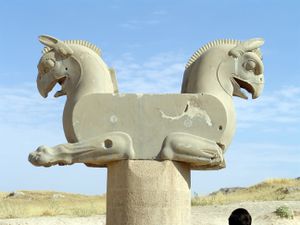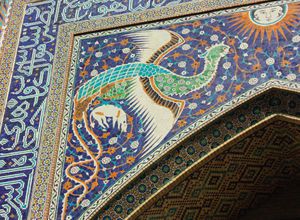「フマ」の版間の差分
(→神話と伝説) |
(→神話と伝説) |
||
| 16行目: | 16行目: | ||
オスマン帝国の詩では、この鳥はしばしば「極楽鳥」と呼ばれている<ref name="divan"/><ref>''cf''. Andrews, Walter, Kalpakli, Mehmet, The Age of Beloveds, 2005, Duke University Press, pages:341–342.</ref>。パラディサス科の種に関する初期のヨーロッパの記述では、この鳥には翼や脚がなく、鳥は生涯空中にいるものと想定されていた。 | オスマン帝国の詩では、この鳥はしばしば「極楽鳥」と呼ばれている<ref name="divan"/><ref>''cf''. Andrews, Walter, Kalpakli, Mehmet, The Age of Beloveds, 2005, Duke University Press, pages:341–342.</ref>。パラディサス科の種に関する初期のヨーロッパの記述では、この鳥には翼や脚がなく、鳥は生涯空中にいるものと想定されていた。 | ||
| − | ペルシャ文学におけるスーフィー作品の代表格であるニシャプールのファリードゥッディーン・アッタール(Attar of Nishapur)の寓話的名作『鳥の言葉(The Conference of the Birds)』では、フマ鳥が旅をすることを拒む弟子のように描かれている。なぜならそのように旅をすれば、飛んでいった相手に王権を与える特権が損なわれるからだ。イランの文献では、このフマ鳥の王権授与の性質は、イスラーム以前の君主に対しても同じようにみなされ、アラブ人の隠喩であるカラスと対をなすものとみなされている<ref>Pourshariati, Parvaneh, Local Historiography in Early Medieval Iran and the Tārīkh-i Bayhaq, Iranian Studies, 33, 1/2, year:2000, pages:133–164, doi:10.1080/00210860008701979, p. 151.</ref>。 | + | ペルシャ文学におけるスーフィー作品の代表格であるニシャプールのファリードゥッディーン・アッタール(Attar of Nishapur)の寓話的名作『鳥の言葉(The Conference of the Birds)』では、フマ鳥が旅をすることを拒む弟子のように描かれている。なぜならそのように旅をすれば、飛んでいった相手に王権を与える特権が損なわれるからだ。イランの文献では、このフマ鳥の王権授与の性質は、イスラーム以前の君主に対しても同じようにみなされ、アラブ人の隠喩であるカラスと対をなすものとみなされている<ref>Pourshariati, Parvaneh, Local Historiography in Early Medieval Iran and the Tārīkh-i Bayhaq, Iranian Studies, 33, 1/2, year:2000, pages:133–164, doi:10.1080/00210860008701979, p. 151.</ref>。フマの伝説はスーフィー派以外の文芸にも登場する<ref>''cf''. <!-- "Balwant Singh on A Terrace Overlooking a River"-->Goswamy, B. N., Nainsukh of Guler: A Great Indian Painter from a Small Hill-State, Artibus Asiae, Supplementum, 41, 1997, pages:5–304, p. 118.</ref>。 |
| − | The | + | The |
The kingship-bestowing function of the Huma bird reappear in Indian stories of the [[Mughal empire|Mughal era]], in which the shadow (or the alighting) of the Huma bird on a person's head or shoulder were said to bestow (or foretell) kingship. Accordingly, the feathers decorating the turbans of kings were said to be plumage of the Huma bird.<ref name="schimmel">{{citation|last=Schimmel|first=Annemarie|last2=Attwood|first2=Corinne| | The kingship-bestowing function of the Huma bird reappear in Indian stories of the [[Mughal empire|Mughal era]], in which the shadow (or the alighting) of the Huma bird on a person's head or shoulder were said to bestow (or foretell) kingship. Accordingly, the feathers decorating the turbans of kings were said to be plumage of the Huma bird.<ref name="schimmel">{{citation|last=Schimmel|first=Annemarie|last2=Attwood|first2=Corinne| | ||
2022年3月25日 (金) 07:59時点における版

フマ(Huma、ペルシア語:هما、発音:Homer、アヴェスター語:Homāio)はペルシア神話上の伝説の鳥であり、[2][3]スーフィーの詩やディヴァン (詩集)で共通のモチーフとして使い続けられている。ペルシアのフェニックスと呼ばれることもあるが、実際には中国の吉兆の鳥、鳳凰と似ている部分が多い。例えば、雌雄を兼ね備えているところがある。だが、フマの場合は半分が雄で、もう半分が雌である。
様々な伝説があるが、共通しているのは、この鳥は地上に降り立つことはなく、生涯、目に見えないほど高いところを飛んで生活すると言われていることである。フマはその影の落ちかかった者すべてに恩恵を与え、ほんのわずかな間でも、その頭に乗ることのできた幸運のものは、王になることが期待できる。
この名前には多くの民間解釈があり、中でもスーフィーの師イナヤット・カーンは「Humaという言葉の中でhuは精神を表し、mahという言葉はアラビア語で水を意味する『Maʼa』 ماءに由来する」と仮定している[4]。
神話と伝説
フマという鳥は、一生休むことなく、目に見えないほど高いところを飛び、地上に降り立つこともないと言われている(脚がないという伝説もある)[5]。
フマの神話のいくつかのバリエーションでは、この鳥は不死鳥のようであり、数百年ごとに火で自らを焼き尽くし、灰の中から新たに立ち上がる、と言われている。フマという鳥は、一体の中に雄と雌の性質を持ち(中国の鳳凰を思わせる)、それぞれの性質が片翼と片足を持っていると言われている。フマは慈悲深く、その影(または触れること)が吉とされることから「幸運の鳥」[6]とされている。
スーフィーの伝統では、フマを捕まえることは想像を超えることだが、その姿を垣間見ること、あるいはその影を見ることは、その人の残りの人生を幸せにすることになるとされている。また、フーマは生きていては捕まえられないと信じられており、フーマを殺した者は40日後に死ぬと言われている[6]。
オスマン帝国の詩では、この鳥はしばしば「極楽鳥」と呼ばれている[6][7]。パラディサス科の種に関する初期のヨーロッパの記述では、この鳥には翼や脚がなく、鳥は生涯空中にいるものと想定されていた。
ペルシャ文学におけるスーフィー作品の代表格であるニシャプールのファリードゥッディーン・アッタール(Attar of Nishapur)の寓話的名作『鳥の言葉(The Conference of the Birds)』では、フマ鳥が旅をすることを拒む弟子のように描かれている。なぜならそのように旅をすれば、飛んでいった相手に王権を与える特権が損なわれるからだ。イランの文献では、このフマ鳥の王権授与の性質は、イスラーム以前の君主に対しても同じようにみなされ、アラブ人の隠喩であるカラスと対をなすものとみなされている[8]。フマの伝説はスーフィー派以外の文芸にも登場する[9]。
The
The kingship-bestowing function of the Huma bird reappear in Indian stories of the Mughal era, in which the shadow (or the alighting) of the Huma bird on a person's head or shoulder were said to bestow (or foretell) kingship. Accordingly, the feathers decorating the turbans of kings were said to be plumage of the Huma bird.[10]
Sufi teacher Inayat Khan gives the bestowed-kingship legend a spiritual dimension: "Its true meaning is that when a person's thoughts so evolve that they break all limitation, then he becomes as a king. It is the limitation of language that it can only describe the Most High as something like a king."[4]
The Huma bird symbolizes unreachable highness in Turkish folk literature.[11] Some references to the creature also appear in Sindhi literature, where – as in the diwan tradition – the creature is portrayed as bringing great fortune. In the Zafarnama of Guru Gobind Singh, a letter addressed to Mughal Emperor Aurangzeb refers to the Huma bird as a "mighty and auspicious bird".
Legacy

- A British Museum catalog captions a photograph of the griffin-like capitals at Persepolis with "Column capital in the form of griffins (locally known as 'homa birds')".[1]
- The Persian language acronym for "Iran National Airline" is HOMA and the airline's emblem has a stylized rendering of a Huma bird.
- The Emblem of Uzbekistan represents the Huma bird.
- Herman Melville briefly alludes to the bird in Moby-Dick. At the beginning of the chapter entitled "The Tail", the narrator speaks of "the bird that never alights."
- It provides the title of Bird's Shadow, a collection of short stories by Ivan Bunin.
- It is also referred to in the movie Days of Being Wild by Wong Kar-wai and the play "Orpheus Descending" by Tennessee Williams.テンプレート:Citation needed
- The literature series Dragonlance named Krynn's greatest hero, Huma Dragonbane, after the Huma bird.
- the asteroid 3988 Huma discovered by Eleanor F. Helin named after the Huma bird. The asteroid's name was suggested by the SGAC Name An Asteroid Campaign[12]
関連項目
参考文献
- Wikipedia:フマ(最終閲覧日:22-03-21)
- Saccone, Carlo, Humā, https://referenceworks.brillonline.com/entries/encyclopaedia-of-islam-3/huma-COM_30551?s.num=22&s.f.s2_parent=s.f.book.encyclopaedia-of-islam-3&s.start=20&s.q=Iranian , 2018
参照
- ↑ 1.0 1.1 1.2 Curtis , John , Tallis , Nigel , Forgotten Empire, the World of Ancient Persia , London , British Museum Press , 2005 , isbn:978-0-7141-1157-5
- ↑ MacKenzie, D. N. ,A concise Pahlavi Dictionary, 2005, Routledge Curzon, London & New York, isbn:0-19-713559-5
- ↑ Mo'in, M., Mohammad Moin, A Persian Dictionary. Six Volumes, 1992, Amir Kabir Publications, Tehran, isb:1-56859-031-8
- ↑ 4.0 4.1 http://wahiduddin.net/mv2/II/II_8.htm , The Mysticism of Music, Sound and Word , Abstract Sound , Khan , Inayat , 1923 , wahiduddin.net
- ↑ Nile, Green, Ostrich Eggs and Peacock Feathers: Sacred Objects as Cultural Exchange between Christianity and Islam, Al Masaq: Islam and the Medieval Mediterranean, 18, 1, 2006, pages:27–78, doi:10.1080/09503110500222328.
- ↑ 6.0 6.1 6.2 http://turkoloji.cu.edu.tr/ESKI%20TURK%20%20EDEBIYATI/batislam.pdf , H. Dilek Batîslam , Mythological Birds of the Classical Ottoman Poetry: Huma, Anka and Simurg. , Türk Kültürü İncelemeleri Dergisi,İstanbul 2002, 185–208 , 3 August 2009 , language=tr
- ↑ cf. Andrews, Walter, Kalpakli, Mehmet, The Age of Beloveds, 2005, Duke University Press, pages:341–342.
- ↑ Pourshariati, Parvaneh, Local Historiography in Early Medieval Iran and the Tārīkh-i Bayhaq, Iranian Studies, 33, 1/2, year:2000, pages:133–164, doi:10.1080/00210860008701979, p. 151.
- ↑ cf. Goswamy, B. N., Nainsukh of Guler: A Great Indian Painter from a Small Hill-State, Artibus Asiae, Supplementum, 41, 1997, pages:5–304, p. 118.
- ↑ テンプレート:Citation.
- ↑ テンプレート:Citation
- ↑ 3988 Huma (1986 LA).{{{date}}} - via {{{via}}}.
